

2017.05.08
H29年度AGL山田道場WHAT'S GOING ON『Lean Launchpad<リーンローンチパッド>』
Facilitators; Takashi Tsutsumi, Masato Iino, Learning Entrepreneurs Lab. Inc<堤孝志、飯野将人 (株)ラーニング・アントレプレナーズ ラボ>
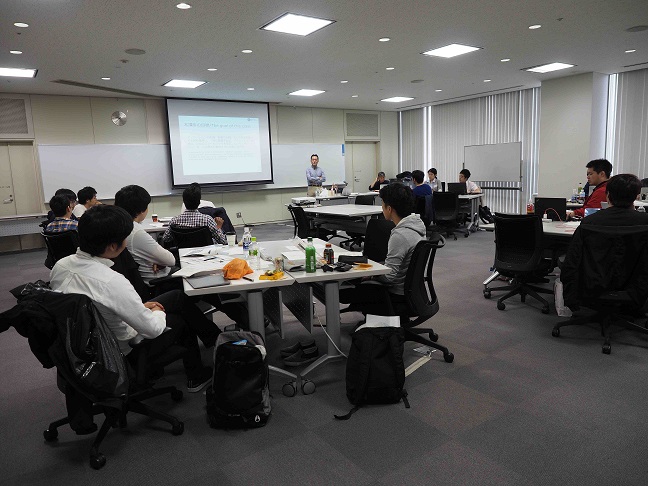
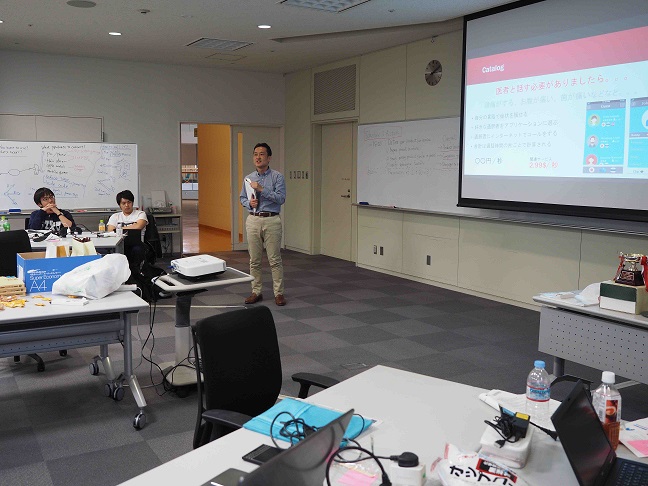
2017年度の「リーン・ローンチパッド」第1回を、4月22日(土)及び23日(日)の2日間に渡り、セミナーハウス クロスウェーブ府中にて行いました。本道場menuは、当道場の濃さ・プログラムとして位置付けており、約2ヶ月間をかけて、学生が持つ新たなサービスや製品のアイデアを、提供するサービスや製品が訴求するポイントはどこにあるのか、その訴求ポイントに価値を認める顧客がいるのかどうかを検証しながら、事業として立ち上げて行きます。本年で6回目ですが、過去の参加者の中には、ビジネスコンペティションでの受賞や複数の企業の立ち上げに関わる学生、このトレーニングで取り上げた案件をそのまま新たな企業として設立し活動している学生も出てきています。
ただ、それらはあくまで結果で、企業を立ち上げることが道場の主目的ではありません。グローバルリーダーの根幹をなす機能と当道場が考えている「自ら課題を設定する」「解決策の提示」「社会のフィードバックを得る」という行動サイクルを身につけ、論理性はいうまでもなく、更に、論理性を超えた飛躍できる発想力・分析力、そして他者と協働して目的を達成する行動力を、実践し、グローバル社会での共通の価値観である「新たな価値を開拓し設定するというマインドセット」を醸成することが主目的です。
全6回を予定していますが、2回目以降は、その間に行った顧客インタビューを元に、提案する新サービスや新製品が、顧客に受け入れられるのか、受け入れられるとしたら、どのポイントがどの程度の要望で受け入れられるのか、受け入れられないとしたら、その理由は、また、どのようにしたら受け入れられるのか、等を検証し発表します。その事実を元に、必要であれば、事業の訴求ポイント、または、顧客セグメントを変更(ピボット)しながら、強くそのサービス・製品を必要とする顧客(アーリー・アダプター)を発掘していきます。
We are pleased to inform you that the 1st round of 2017 LLP was held on 22-23/Apr at Cross Wave Fuchu. Lean Launchpad (LLP) is the core program of AGL/Yamada Dojo to build up new business by clarifying which character(s) of the products (services) should be claimed and whether or not the customers which appreciate such characters are exist by taking almost 2 months of period. This 2017 LLP is the 6th LLP held in AGL/Yamada Dojo. A student who joined LLP in the past got a prize in the business competition and is engaged in establishing new businesses and some of students who joined LLP in the past are engaged in further steps to materialize their new business ideas.
Establishing new business, however, should not be the main purpose of this program, just results generated from this program. While LLP is designated as the core program in AGL/Yamada Dojo. We believe that it should be helpful for students to foster "leadership" on global level to learn cycle of real activities; establishing "issues" by yourself, then presenting "solutions" for those issues, and obtaining "feedback" from society, as Yamada Dojo defines that those are fundamental capabilities for global leaders.
Further to previous round, we are planning t have 6 times of classes from now. After the 1st round, all teams are going to report if the products and services the students raised would be acceptable for the customers, if yes, which points would be accepted by customers, if not, which points the customers' are not accepted. The main purpose of this work should be finding "early adopters" who are eager to have the new products (services) the students present.
今回は、今期第1回(LLP #1)で、2日間合宿の間に、下記を行なっていきます。
1. チーム決定
2. アイデアからビジネスモデルへの検討
3. Minimum Viable Product(MVP)とは
4. 顧客インタビューに向けて
This memo is reporting LLP#1, 2day camp, as follows;
1. Building team
2. Idea to business model
3. Minimum Viable Products(MVP)
4. Preparation for interviews to the customers
I. 1日目/Day 1(09:00-18:30):
集合は、セミナーハウス クロスウェーブ府中に09:00で、09:30より、スタートしました。
1. チーム決定/Building Teams:
あらかじめ考えてきた新事業アイデアを、個人参加は各自一人ずつ、チーム参加はチームで、それぞれ3分程度のピッチを行います。参加者全員で、自分のアイデア以外に面白いと思うアイデアの人気投票を行い、その結果を元に、事業アイデアとチームを決めます。チーム参加でも、このピッチで、新たなメンバーが加わる可能性があると同時に、そのアイデアの売り出す製品やサービスがはっきりしない、場合や、顧客や収益モデルがイメージできない場合などは、テーマとされない場合もあります。テーマの選定やチーム分けは、堤さん、飯野さん、山田で決めます。色々調整が大変でしたが、最終的に、下記5チームとしました。
(1)"Moving Tap"; 自走式テーブルタップ(電源コード):間中、黄、赤木
(2)"UNICOM"; 講義中の学生と教員のコミュニケーションを促進するグループウェア:Robin、甲斐、Son、高岸
(3)"Hapbeat"; 体に巻きつける紐で音の振動を体感できる小型デバイス:山崎、織田、Santosh、小智
(4)"Music Tree"; 音大生によるオンライン演奏レッスン:佃、岩本、李
(5)"ICS"; 海外訪日者向け急病アシスト:Paniti、林、Marcos
3 minutes pitches about new business idea were presented by each participant and team which had been formed in advance. Then, all participants voted top 5 ideas except for own idea. Based on such votes, Tsutsumi-san, Iino-san and Yamada picked up 5 business ideas by considering clearness of products(service) idea and possibility of possible customers and revenue model. Finally, following 5 themes were picked up as the theme for 2017 LLP with team members;
(1)"Moving Tap"; self moving power table tap(power cable) :Manaka, Huang, Akagi
(2)"UNICOM"; A groupware to encourage communication between students and tutor: Robin, Kai, Son, Takagishi
(3)"Hapbeat"; A portable "body-sonic" device by a string: Yamazaki, Oda, Santosh, Ochi
(4)"Music Tree"; On-line instrumental play teaching by music school students: Tsukuda, Iwamoto, Li
(5)"ICS"; Assisting oversea visitors from minor language countries for their communication with hospitals/doctors about their urgent illness: Paniti, Hayashi, Marcos
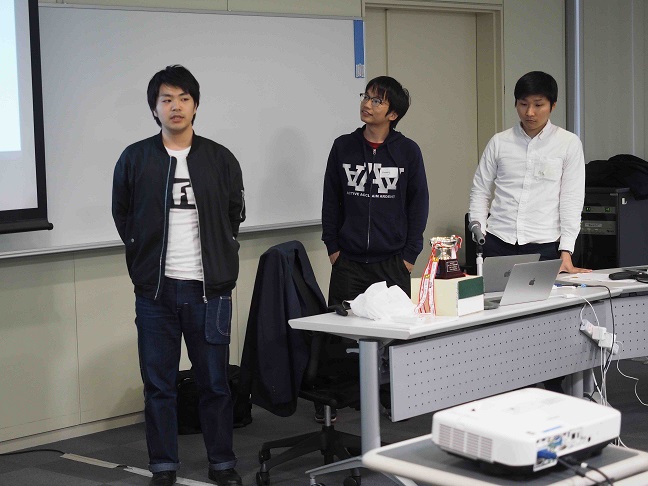
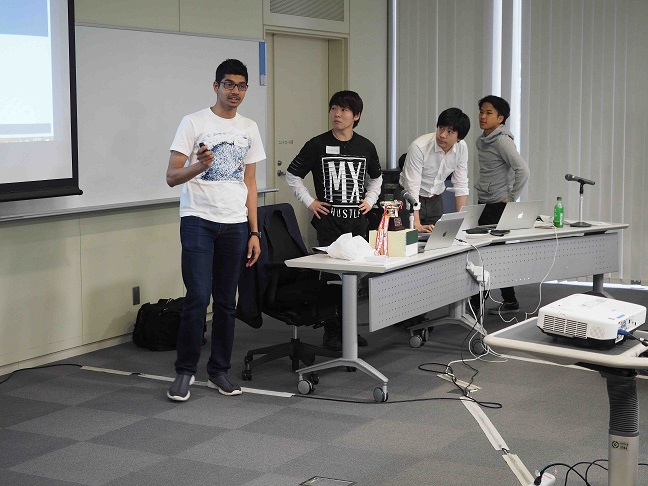
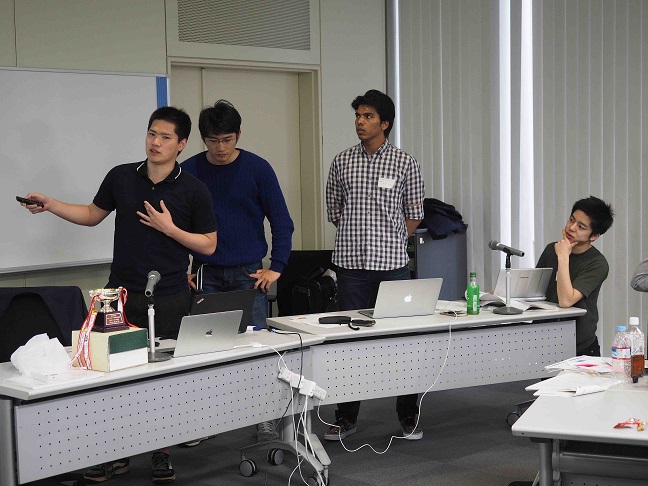
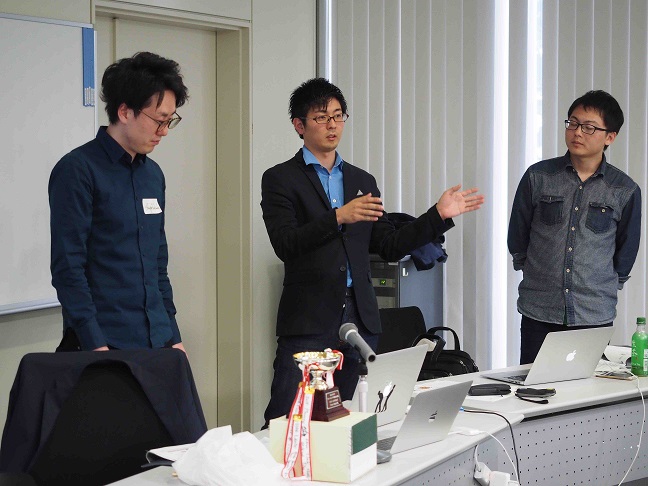
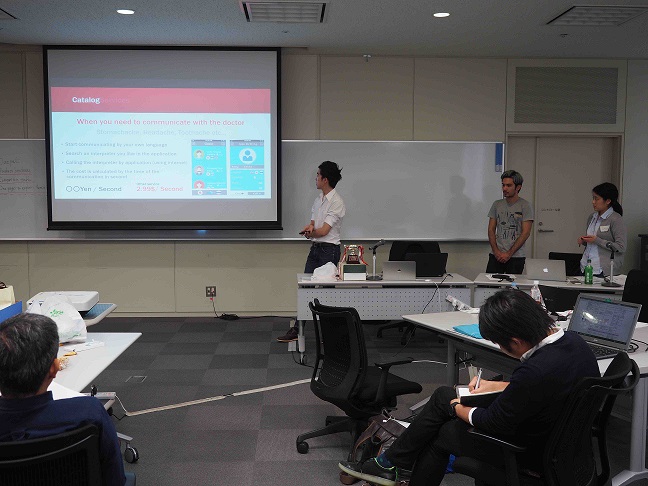
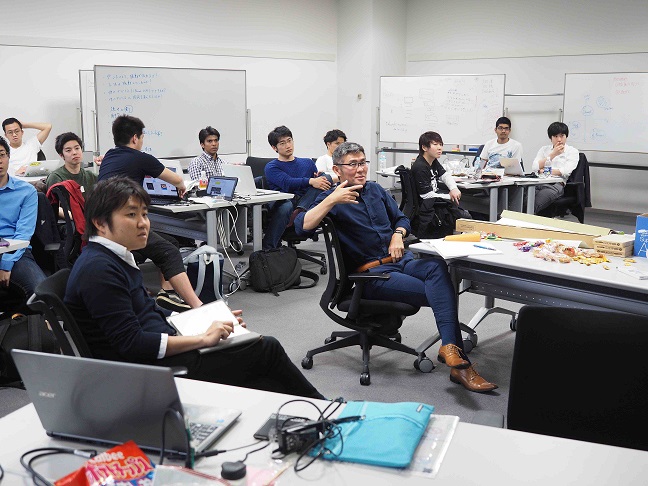
2. アイデアからビジネスモデルへの検討/Studying from idea to the business model:
ビジネスモデルの3要素である「何を売り」「誰に売り」「どう対価を得るのか」を検討していきます。検討手順は下記です。
(1) 製品 or サービス内容の検討と確定(カタログの作成)
(2) 製品 or サービス内容の発表
(3) 儲け方の検討
(4) 対象顧客の発散的検討
Three basic elements for business model; "what to sell", "to who" and "how to get paid" were studied. The process for studying a follows;
(1) Define your products/services
(2) Present your products/services
(3) Define how to monetize
(4) Identify target customers and make a long list
価値・顧客シートは、①顧客とその困りごと、つまり、ニーズのメカニズムを仮定し、②製品(性能)とその価値を規定し、③売上を計算するものです。これを、対列挙した対象顧客ごとに作成していきます。
Value Proposition Customer Segment Sheet are consist from 3 elements; ①Customer and its mechanism of needs, ②a product and its value proposition and ③revenue model. This sheet was prepared by each customer segment.
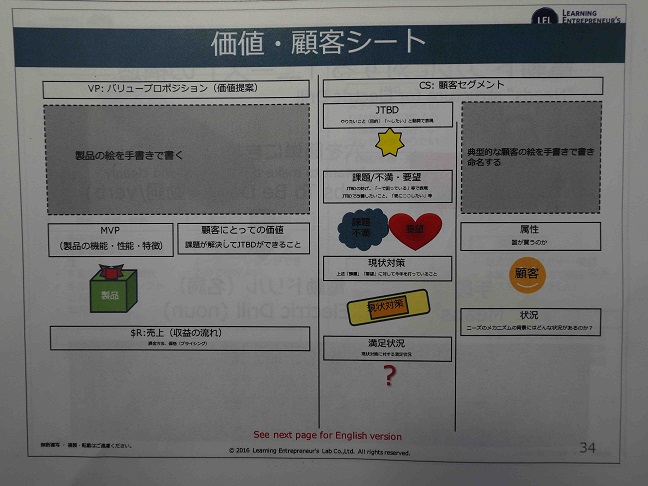
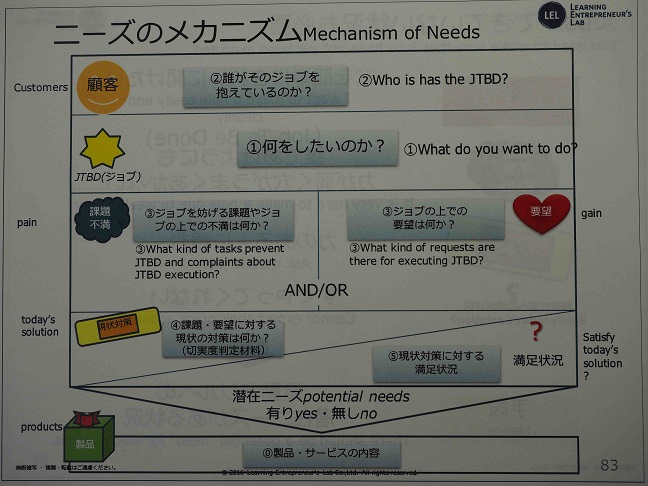
ここは、今後のインタビューを行っていく上でのスタート・ポイントとなることから極めて重要な作業となります。顧客が、製品(サービス)を提供する側、受ける側にもいる場合もあり、結構複雑になる場合もあります。各チーム、かなり突っ込んだ議論が必要になるところでもあります。
This work was very important because the work of this section would be starting point for coming series of interviews. In some case, the structure may be complicated in case the customers exist in both product(service) side and user side. Each team had a deep discussion until mid night.
本日のmenuは、18:30に終了し、その後、懇親会を行いましたが、各チームは、懇親会後も、議論や作業に追われていたようです。
All agenda of this 1st day was completed by 18:30, then we had a diner party. All teams, however, re-started discussions and works after the party until midnight.
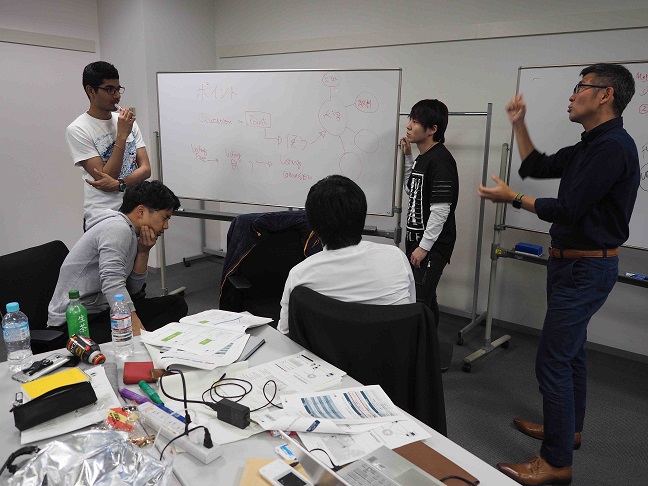
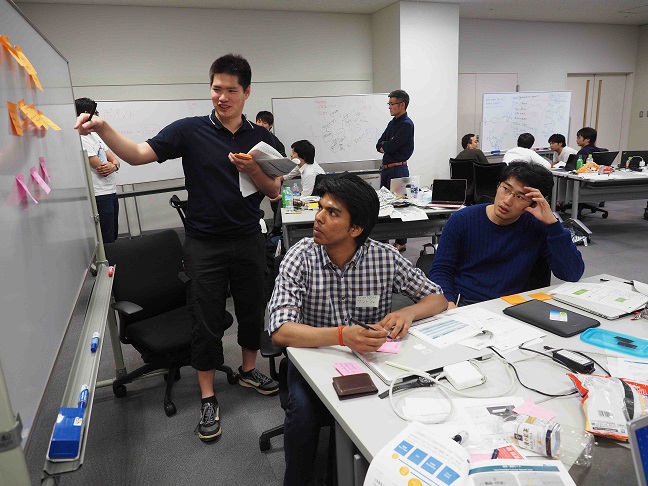
II. 2日目/Day 2 (09:00-18:00):
1日目で検討した、顧客ごとの価値顧客シートの発表・ファシリテーターからのコメントからスタートします。
Day 2 was started with presentation about "Value Proposition Customer Segment Sheet completed yesterday by each team.
1. Minimum Viable Products; MVP:
ニーズを検証するため「顧客の切実なニーズを過不足なく満たす必要最小限の製品」のこと。これは、どうしても完璧を目指して膨張してしまいがちな機能追加を排除し、仮説検証にとって不可欠な「どこが顧客にとって意味があるのか」を見極めることができます。アーリー・アダプターが必要としない部分は、「無駄」と理解する。これが、「リーン」の所以でもあります。MVPを決めていくにあったてのポイントは下記3点。
(1) 明確化:顧客価値シートのMVP欄を埋めて、MVPの明確化
(2) 机上確認:類似品が既に存在しないかの確認
(3) 差別化要素:類似品がある場合、類似品に対する差別化要素を明らかにする。ニーズの検証ではその差別化要素に価値があることを検証する。
MVP; Minimum Viable Products, should be defined and used when you engage in hypothesis testing; the products which satisfy customers' most serious needs. Entrepreneurs are often trying to add further functions to be perfect, so that it becomes difficult to identify which value (specification) would be a key for customer. There are 3 points when you define MVP;
(1) Clarification of MVP: filling "MVP" column in Value Customer Sheet (including Product concept)
(2) Similar products/services check: if or not such similar products/services are available
(3) Clarification of advent (difference): during the process of "needs" testing, confirm if the elements of such difference have the value
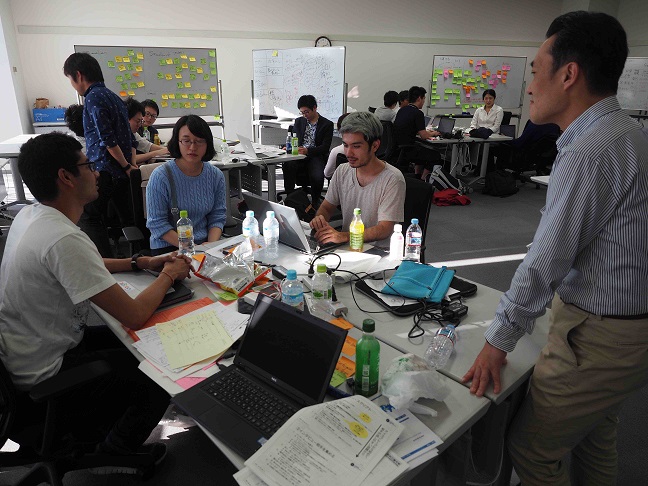
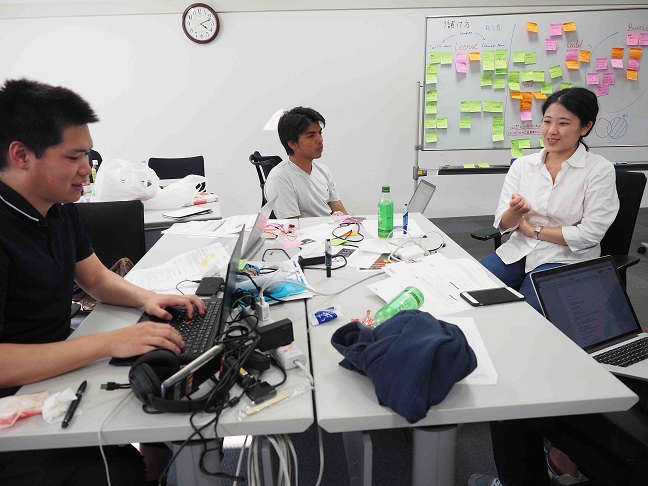
2. インタビューに向けて/ Preparation for interviews to the customers:
目的の明確化:
・ニーズの検証:
・欲しがる人がいることの検証
・欲しがる動機の存在とともにプロダクト・マーケットフィットを確認
・アーリー・アダプターの像の特定:
・顧客の状況や価値観についての理解を深める
・アーリー・アダプターの像とニーズのメカニズムの特定
インタビューの練習を行いました。
Clarifying purpose of interviews:
・Testing hypothesis of customer needs
・To test if there are any customers who have a need and its mechanism
・To test if a product fit with needs and its mechanism
・Specify the profile of customers who have needs for a product
・To deeply understand a situation and value at customers
・To specify the profile and mechanism of needs for customers
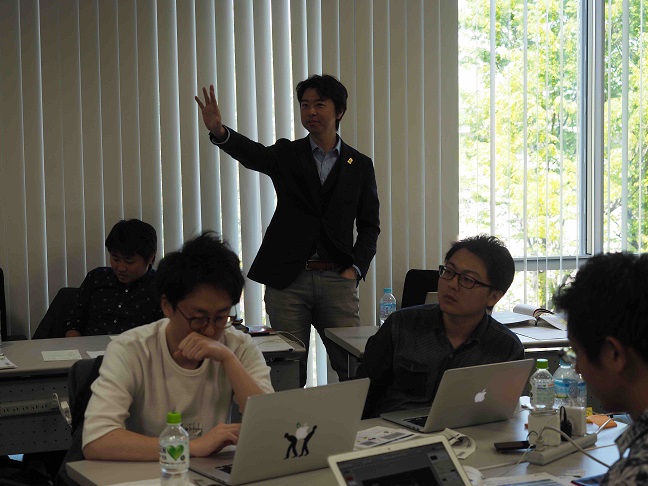
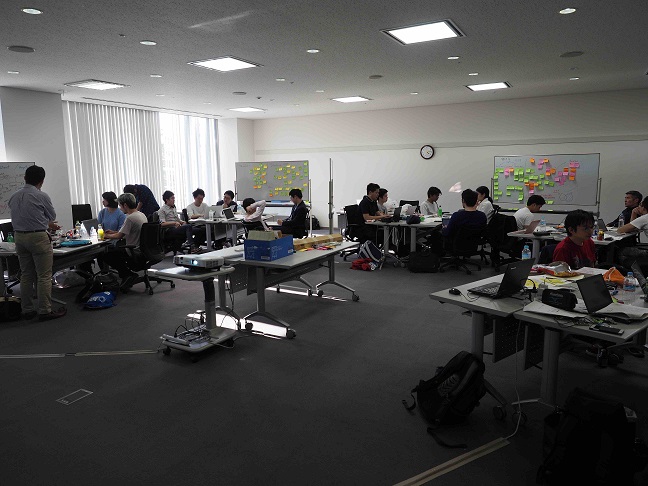
III. まとめ/Summary:
・新規事業の立ち上げでは当初の想定はしばしば間違っている
・「作れない失敗」ではなく「作ったけど売れない」リスク
・製品サービスの開発中から実験を素早く繰り返し"顧客を開発"することで「作ったけど売れない」リスクを減らす
・アーリー・アダプターと話をして構造的なメカニズムに裏付けられた切実なニーズを確認し、MVPが有償で売れるか確かめる
・ニーズが検証されるまではムダな使用なしにリーンに進める
そして、最後は、次回までの宿題を確認して合宿を終了しました。
・It often happens that the beginning hypothesis behind a new businesss development is wrong.
・Rather than "failure to make", the risk could be "failure to sell what was made"
・Reduce risk of "failure to sell what was made" by engaging in "customer development", and rapid repetitive testing during the development of products/services
・Interview early adopters to develop a structural mechanism to test and confirm essential needs, and the possibility of selling a MVP at a price.
・Proceed with a "Lean" structure to avoid wasteful specifications while confirming needs.
In the end of the 2 day camp, all participants confirmed homework as follows;
IV. 宿題/Homework:
・顧客インタビューを行い、ビジネスモデル仮説を検証。インタビューは原則10件以上
・全てのインタビューについてインタビューメモを作成する。作成の都度、講師に送付する。
・インタビューメモを集約し、考察した上で「検証結果シート」にまとめる。
・次回にかきスライドで発表する:
・表紙
・製品・サービスの概要
・初期の価値。顧客シート
・検証結果シート
・検証完了か、ピボットかの結論
・最新の価値・顧客シート
・全体を通しての学び
・Engage in interviews with customers and test hypothesis of business model. Over 10 interviews are requested.
・Write an interview memo for each interview, and send it to your tutor immediately each time.
・Prepare a "Test Result Sheet" after studying of all interviews.
・I the next class, each team will make a reporting presentation with slides covering following;
・Cover page with group name and logo
・Outline of products /services
・Initial "Value and Customer Sheet"
・Test result Sheet by clarifying number of interviews
・Conclusion of "completion of test" or "pivot"
・The latest Value Customer Sheet
・Your comments on what you have learned.
次回、LLP#2は、5月12日(金)10:00-@石川台7号館(ELSI-1)ELSIホールです。先立って、ホワートボードの搬入・机の配置変えを行いますので、参加学生は、09:20@現地で、お集りください。
Next LLP#2 will be held on 12/May(Fri) 10:00-@ELSI hall, Ishikawa-dai Building 7 (ELSI-1) . In advance to the class, all students are being requested to gather at ELSI hall at 09:20 in order to bring whiteboards in and re-arrangement of desks of the hall.
(2/May/2017 山田道場主)









